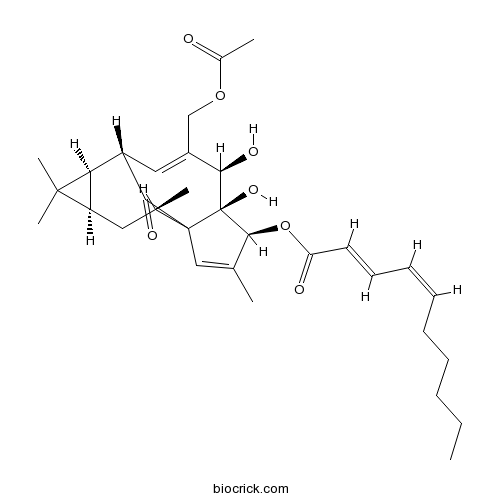3-O-(2'E ,4'Z-decadienoyl)-20-O-acetylingenolCAS# 158850-76-1 |

- 3-O-(2'E ,4'E-decadienoyl)-20-O-acetylingenol
Catalog No.:BCN1437
CAS No.:466663-12-7
Quality Control & MSDS
3D structure
Package In Stock
Number of papers citing our products

| Cas No. | 158850-76-1 | SDF | Download SDF |
| PubChem ID | 102004599 | Appearance | Powder |
| Formula | C32H44O7 | M.Wt | 540.7 |
| Type of Compound | Diterpenoids | Storage | Desiccate at -20°C |
| Solubility | Soluble in Chloroform,Dichloromethane,Ethyl Acetate,DMSO,Acetone,etc. | ||
| SMILES | CCCCCC=CC=CC(=O)OC1C(=CC23C1(C(C(=CC(C2=O)C4C(C4(C)C)CC3C)COC(=O)C)O)O)C | ||
| Standard InChIKey | SYXKKJDQNXPUSI-VNTMLSECSA-N | ||
| General tips | For obtaining a higher solubility , please warm the tube at 37 ℃ and shake it in the ultrasonic bath for a while.Stock solution can be stored below -20℃ for several months. We recommend that you prepare and use the solution on the same day. However, if the test schedule requires, the stock solutions can be prepared in advance, and the stock solution must be sealed and stored below -20℃. In general, the stock solution can be kept for several months. Before use, we recommend that you leave the vial at room temperature for at least an hour before opening it. |
||
| About Packaging | 1. The packaging of the product may be reversed during transportation, cause the high purity compounds to adhere to the neck or cap of the vial.Take the vail out of its packaging and shake gently until the compounds fall to the bottom of the vial. 2. For liquid products, please centrifuge at 500xg to gather the liquid to the bottom of the vial. 3. Try to avoid loss or contamination during the experiment. |
||
| Shipping Condition | Packaging according to customer requirements(5mg, 10mg, 20mg and more). Ship via FedEx, DHL, UPS, EMS or other couriers with RT, or blue ice upon request. | ||
| Description | 1. 3-O-(2′E,4′Z-decadienoyl)-20-O-acetylingenol, one toxic terpenoid from raw Gansui. 2. 3-O-(2′E,4′Z-decadienoyl)-20-O-acetylingenol has strong cytotoxicity against human normal cell lines L-O2 and GES-1 with dose-dependent relationships . 3. 20-O-acetyl-[3-O-(2'E,4'Z)-decadienoyl]-ingenol and 3-O-(2'E,4'Z)-decadienoylingenol show the same antinematodal activity against the nematode, Bursaphelenchus xylophilus, at a minimum effective dose (MED) of 5 microg/cotton ball. 4. 3-O-(2'E,4'Z-decadienoyl)-20-O-acetylingenol induces the cytotoxicity of intestinal epithelial cells of rats (IEC-6 cells) depends on induction of cell apoptosis via mitochondrial pathway and cell cycle arrest. 5. 3-O-(2'E,4'Z-decadienoyl)-20-O-acetylingenol, kansuinine B and kansuinine A can markedly promote SPL proliferation and NO production by PMphi at concentrations from 0.78 to 12.50 microg/mL, hence the they are believed to be important proinflammatory components of the roots of E. kansui. |
| Targets | NO | Antifection |

3-O-(2'E ,4'Z-decadienoyl)-20-O-acetylingenol Dilution Calculator

3-O-(2'E ,4'Z-decadienoyl)-20-O-acetylingenol Molarity Calculator
| 1 mg | 5 mg | 10 mg | 20 mg | 25 mg | |
| 1 mM | 1.8495 mL | 9.2473 mL | 18.4945 mL | 36.9891 mL | 46.2364 mL |
| 5 mM | 0.3699 mL | 1.8495 mL | 3.6989 mL | 7.3978 mL | 9.2473 mL |
| 10 mM | 0.1849 mL | 0.9247 mL | 1.8495 mL | 3.6989 mL | 4.6236 mL |
| 50 mM | 0.037 mL | 0.1849 mL | 0.3699 mL | 0.7398 mL | 0.9247 mL |
| 100 mM | 0.0185 mL | 0.0925 mL | 0.1849 mL | 0.3699 mL | 0.4624 mL |
| * Note: If you are in the process of experiment, it's necessary to make the dilution ratios of the samples. The dilution data above is only for reference. Normally, it's can get a better solubility within lower of Concentrations. | |||||

Calcutta University

University of Minnesota

University of Maryland School of Medicine

University of Illinois at Chicago

The Ohio State University

University of Zurich

Harvard University

Colorado State University

Auburn University

Yale University

Worcester Polytechnic Institute

Washington State University

Stanford University

University of Leipzig

Universidade da Beira Interior

The Institute of Cancer Research

Heidelberg University

University of Amsterdam

University of Auckland

TsingHua University

The University of Michigan

Miami University

DRURY University

Jilin University

Fudan University

Wuhan University

Sun Yat-sen University

Universite de Paris

Deemed University

Auckland University

The University of Tokyo

Korea University
- GR 159897
Catalog No.:BCC7001
CAS No.:158848-32-9
- Escin IIB
Catalog No.:BCN8127
CAS No.:158800-83-0
- Salvianolic acid F
Catalog No.:BCN2924
CAS No.:158732-59-3
- Aescin IIA
Catalog No.:BCN6551
CAS No.:158732-55-9
- 2-Naphthyl N-benzoylphenylalaninate
Catalog No.:BCC8583
CAS No.:15873-25-3
- Dihydrexidine hydrochloride
Catalog No.:BCC5681
CAS No.:158704-02-0
- Rimonabant hydrochloride
Catalog No.:BCC1898
CAS No.:158681-13-1
- Ombuin 3-glucoside
Catalog No.:BCN4055
CAS No.:158642-42-3
- Eclalbasaponin I
Catalog No.:BCN8244
CAS No.:158511-59-2
- Cnidioside B methyl ester
Catalog No.:BCN1707
CAS No.:158500-59-5
- Catalpalactone
Catalog No.:BCN1708
CAS No.:1585-68-8
- ω-Agatoxin TK
Catalog No.:BCC7489
CAS No.:158484-42-5
- Boc-ß-HoAla-OH
Catalog No.:BCC3224
CAS No.:158851-30-0
- 3Alaph-Tigloyloxypterokaurene L3
Catalog No.:BCN6787
CAS No.:1588516-87-3
- ent-17-Hydroxykaura-9(11),15-dien-19-oic acid
Catalog No.:BCN6788
CAS No.:1588516-88-4
- BET-BAY 002
Catalog No.:BCC5510
CAS No.:1588521-78-1
- GR 231118
Catalog No.:BCC7085
CAS No.:158859-98-4
- APC 366
Catalog No.:BCC7392
CAS No.:158921-85-8
- Boc-D-Tryptophanol
Catalog No.:BCC2698
CAS No.:158932-00-4
- Secoisolarisiresinol Diglucoside
Catalog No.:BCC9140
CAS No.:158932-33-3
- Wedelobatin A
Catalog No.:BCN6731
CAS No.:1589488-34-5
- Wedelobatin B
Catalog No.:BCN6730
CAS No.:1589488-35-6
- 6-Benzyloxyindole
Catalog No.:BCC8769
CAS No.:15903-94-3
- F1839-I
Catalog No.:BCN6450
CAS No.:159096-49-8
Ultra-performance liquid chromatography-quadrupole/time-of-flight mass spectrometry analysis of the impact of processing on toxic components of Kansui Radix
BMC Complem. Altern. M., 2016, 16(1):1-8.
Results showed that processing with vinegar caused conspicuous chemical changes. Among the altered components, 11 toxic terpenoids, 3-O-benzoyl-13-O- dodecanoylingenol/20-O-benzoyl-13-O-dodecanoylingenol, kansuinine D, kansuinine A, 3-O-benzoyl-13-O-dodecanoylingenol/20-O-benzoyl-13-O-dodecanoylingenol, 3-O- benzoylingenol/20-O-benzoylingenol, 20-O-(2′E,4′Z-decadienoyl)ingenol/20-O-(2′E,4′E- decadienoyl)ingenol/3-O-(2′E,4′Z-decadienoyl)ingenol/3-O-(2′E,4′E-decadienoyl)ingenol, 3-O-(2′E,4′Z-decadienoyl)-20-deoxyingenol,3-O-(2′E,4′Z-,ecadienoyl)-5-O-acetylingenol,3-O-(2′E,4′Z-decadienoyl)-20-O-acetylingenol,3-O-(2,3-dimethylbutanoyl)-13-O-dodecanoylingenol, were tentatively identified. The contents of most of these terpenoids were obviously decreased after processing with reductions of 6.66–95.25 %.Our findings could help us understand the chemical basis for the toxicity reduction of Gansui afforded by processing with vinegar. Further investigations are warranted to establish the relationship between processing-induced chemical changes and the reduction of toxicity of Gansui.


